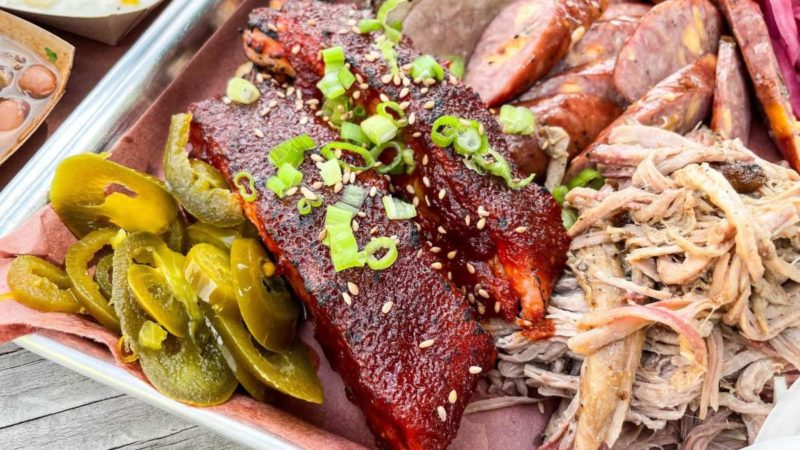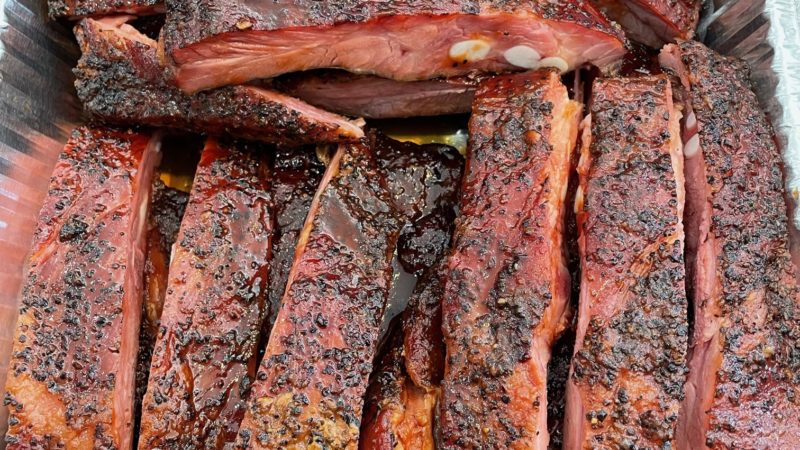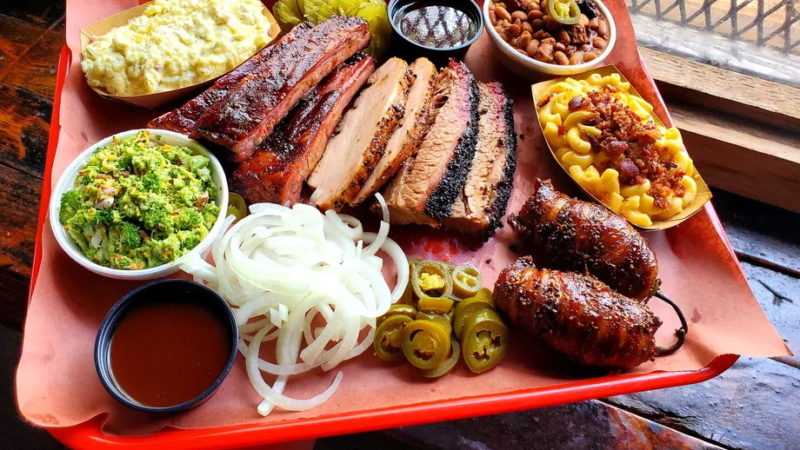South Texas llamas loved for their fuzziness and their fierceness in face of danger
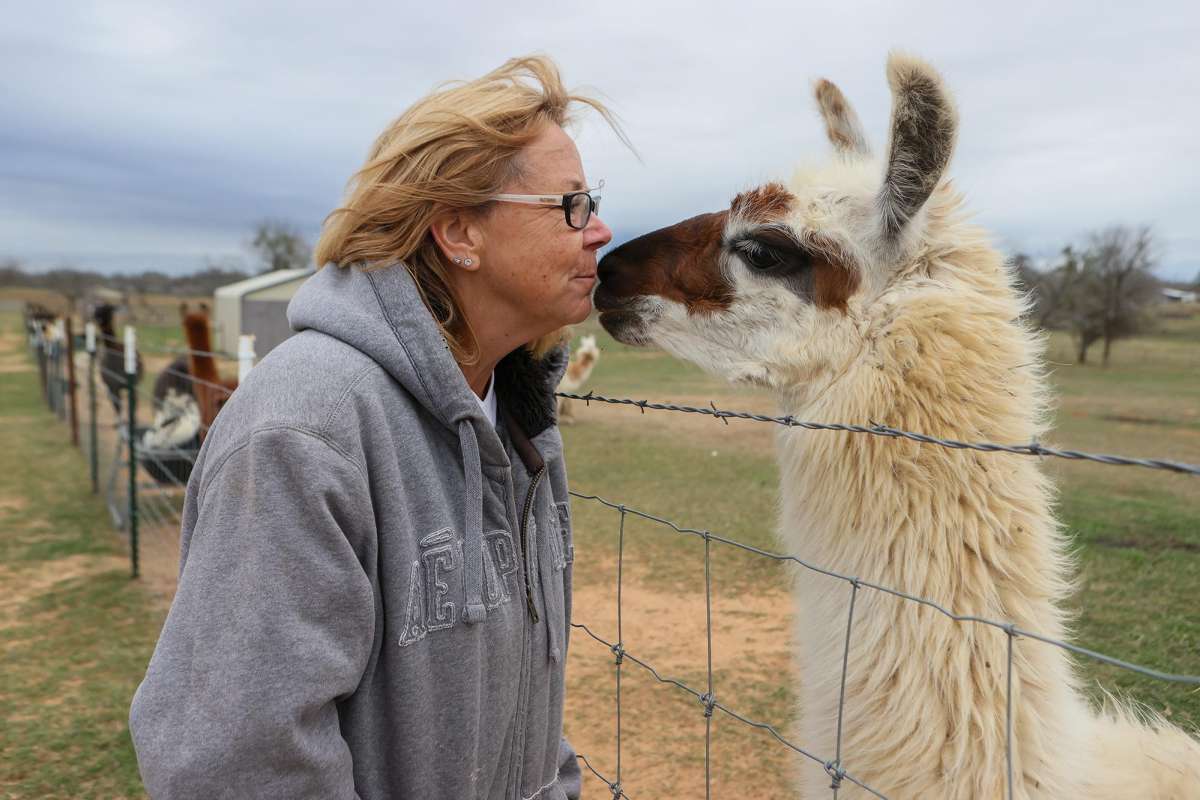
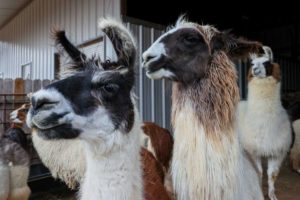 Never underestimate the soothing power of llamas. Just ask Susan Leslie, proud llama mama to 60 of the calmest and cuddliest camelids in South Texas.
Never underestimate the soothing power of llamas. Just ask Susan Leslie, proud llama mama to 60 of the calmest and cuddliest camelids in South Texas.
Across her 10-acre farm in Seguin, the many llamas short and tall, brown and white, spotted and solid poke their long woolly necks over farm fences and barn gates, each with its own tale of kindness.
Poco, a medium-wool 8-year-old, once walked a fashion show runway with a model and granted the birthday wish of a 10-year-old girl with cancer to take a llama for a walk. JJ, a black and white classic llama, often visits nursing homes as a therapy animal. Ziggy, a silky behemoth at 6 ½ feet tall and 425 pounds, poses for bride and groom photos at weddings. And bottle baby llama Torrey gladly gives kisses to preschoolers.
“I guess one phrase I’ve used to describe them is they are food for the soul,” said Leslie, owner of Leslie Lane Farm and a llama breeder for more than 20 years. “There’s just this calming effect to them.”
Ain’t no drama with Leslie’s llamas, or really any of these Peruvian pack animals with a soft disposition to match their silky wool.
“Llamas are very quiet (and) they can be super friendly,” said Kelsey Crandall, an animal care specialist at the San Antonio Zoo who raised her own two llamas that lived around 25 years. “They’re very, very smart and curious animals. But they’re also known as guard animals, and they can be very protective and loyal to their herd.”
They’re also all the rage, having joined the sloth and the unicorn as the other It animal to launch a 1,000 Internet memes and grace cakes, notebooks and other merchandise. Though like Crandall, Leslie also has loved llamas long before it was cool.
In 2000, Leslie started her own llama farm in Ohio with just a fluffy female and a gelding. By the time she moved to Texas in 2007, she had 16 llamas. Since she got her ranch for the llamas in Seguin, she’s grown the flock to 60.
Susan Leslie gives a kiss to Jazzy, a 3-year-old female llama, at Leslie Lane Farm in Seguin. Leslie has 60 llamas, which welcome visitors as well as visit schools, nursing homes and other sites.
Llamas and Christmas go together like so many other llama merchandising.
Peasant Pacha and Emperor Kuzco (who has been turned into a llama by his scheming advisor, Yzma) in the 2000 Disney film,
Never underestimate the soothing power of llamas. Just ask Susan Leslie, proud llama mama to 60 of the calmest and cuddliest camelids in South Texas.
Across her 10-acre farm in Seguin, the many llamas short and tall, brown and white, spotted and solid poke their long woolly necks over farm fences and barn gates, each with its own tale of kindness.
Poco, a medium-wool 8-year-old, once walked a fashion show runway with a model and granted the birthday wish of a 10-year-old girl with cancer to take a llama for a walk. JJ, a black and white classic llama, often visits nursing homes as a therapy animal. Ziggy, a silky behemoth at 6 ½ feet tall and 425 pounds, poses for bride and groom photos at weddings. And bottle baby llama Torrey gladly gives kisses to preschoolers.
“I guess one phrase I’ve used to describe them is they are food for the soul,” said Leslie, owner of Leslie Lane Farm and a llama breeder for more than 20 years. “There’s just this calming effect to them.”
JJ the llama of Leslie Lane Farm visits a nursing home. Farm owner Susan Leslie breeds llamas and uses some as therapy animals.
JJ the llama of Leslie Lane Farm visits a nursing home. Farm owner Susan Leslie breeds llamas and uses some as therapy animals.
Susan Leslie
Ain’t no drama with Leslie’s llamas, or really any of these Peruvian pack animals with a soft disposition to match their silky wool.
“Llamas are very quiet (and) they can be super friendly,” said Kelsey Crandall, an animal care specialist at the San Antonio Zoo who raised her own two llamas that lived around 25 years. “They’re very, very smart and curious animals. But they’re also known as guard animals, and they can be very protective and loyal to their herd.”
They’re also all the rage, having joined the sloth and the unicorn as the other It animal to launch a 1,000 Internet memes and grace cakes, notebooks and other merchandise. Though like Crandall, Leslie also has loved llamas long before it was cool.
In 2000, Leslie started her own llama farm in Ohio with just a fluffy female and a gelding. By the time she moved to Texas in 2007, she had 16 llamas. Since she got her ranch for the llamas in Seguin, she’s grown the flock to 60.
A boy poses with Little Stormie, one of the many llamas from Leslie Lane Farm in Seguin. Farm owner Susan Leslie breeds llamas and also offers picture taking with the animals.
A boy poses with Little Stormie, one of the many llamas from Leslie Lane Farm in Seguin. Farm owner Susan Leslie breeds llamas and also offers picture taking with the animals.
Susan Leslie
When Leslie’s not hiring out her llamas for runways and other events, she hosts tours at her farm. And as much as Leslie loves to see her llamas brighten faces, she also cherishes the warm glow she gets every time she and several of her llamas watch the sunset from her front porch.
“It’s just… ahhhh,” Leslie said.
Here’s a closer look at the chill llama.
A North American native that came back home. The domestic llama (Lama glama) is a from South America and a member of the camel family. The llamas you see today in the United States and Canada were imported in the late 20th century.
Llamas originally roamed the central plains of North America around 40 million years ago, then migrated to South America 3 million years ago. North American camelids later went extinct during the Ice Age, around 10,000 years ago.
The Incas first domesticated llamas around 5,000 years ago, primarily as beasts of burden but also as a source of food and clothing. Llamas are synonymous with Peru, where you’ll find them in many streets as well as in the Andes Mountains at peaks such as Machu Picchu.
Not so big in the USA. While several million llamas roam South America, the U.S. is home to fewer than 40,000 llamas. Leslie, who hires out her shearing services to the San Antonio and Austin areas, estimates there are less than 50 llamas in the Alamo City, though you can own up to two llamas in San Antonio with a livestock permit.
Llamas are raised for their wool. Often when Leslie shears llamas, she’ll clean the fleece and then send it to a mill, where it’s washed and spun into yarn for rugs, blankets and other products that are shipped back to her.
Llamas produce a soft, oil-free wool that’s lightweight yet great for keeping warm. Llamas have two coats: thick guard hair that’s used for ropes and soft down that’s good for spinning into yarn.
They also make great livestock guards. Most llama owners in Texas have a single llama as a livestock guard, Leslie said. Those llamas will protect sheep and other livestock from coyotes and hunting dogs.
Llamas usually drive off predators with a high-pitched scream, though they’ll also bite, stomp and spit.
“Those soft cuddly little things can get super fierce when something is trying to attack their family,” Leslie said.
Like a camel without the hump. Llamas look a lot like fancy camels that traded their humps for extra wool, which comes in a variety of colors, though often brown or white. They also have feet, not hooves, with two toes.
With their long necks, llamas reach average heights of around 5 ½ feet tall from the ground to the top of their head. Full-grown llamas weigh anywhere from a bit less than 300 pounds to a bit more than 400 pounds and live around 15 to 25 years.
Not an alpaca. Llamas and alpacas are both camelids, but they have their differences. Llamas are about twice the size of alpacas. Also, llamas have long, banana-shaped ears, while alpacas have short pointy ears.
Happy herbivores. Llamas mostly eat hay and grain, though they’ll also chomp on some fruits and veggies (and at Leslie’s farm, the occasional cookie).
Yes, they spit, but mostly at each other. Like camels, llamas will spit if agitated, but they’re more likely to aim at each than humans.
“Usually it’s a defense mechanism or a warning mechanism that (another llama is) making them unhappy or to back off,” Crandall said.
They give birth to cute little crias. A baby llama is called a cria, the Spanish word for baby. Llamas give birth standing up and usually have a single cria every one to two years, Leslie said.
The ladies huddle around mother and child. Female llamas will surround a female giving birth to protect mother and child from any pesky males or predators.
A Christmas meme with legs. Llama-mania broke out around 5 years ago with the rise of the “Fa La La La Llama” Christmas sweaters and other related merch. That gift has since kept on giving with llamas now on just about everything from cakes and throw pillows to towels and pajamas.
Llamas that got their groove in pop culture. Famous llama characters go back to at least 2000 with Kuzco, the egotistical Inca ruler who’s transformed into a llama in the Disney animated film, “The Emperor’s New Groove.” Then there’s the 2005 children’s book “Llama Llama Red Pajama,” which saw a resurgence when author Anna Dewdney died in 2016. Now the big llama in pop culture is the Loot Llama, the colorful supply piñata in the video game “Fortnite.”


